By Robert Verkerk PhD Executive and scientific director, ANH-Intl
28 years after the worst industrial accident the world has seen
Bhopal, India. Synonymous still, nearly 30 years on, with the greatest industrial accident of all time; the leak of methyl isocyanate (MIC) gas from Union Carbide’s pesticide factory that killed over 3,000 people within a few days of its release on the night of 2nd and 3rd December, 1984. Thousands more died in subsequent years as a direct result of gas-related diseases, but tragically, ongoing exposure to chemicals in the vicinity of the disused site continues to wreak havoc among the local population.

The incident at Bhopal triggered one of my first forays into activism when, at the ripe old age of 23, I got heavily involved in an international boycott of Union Carbide products as a volunteer with the Total Environment Centre in Sydney, Australia. Knowing something of the background, I was initially bemused by the choice of Bhopal as the venue for the 5th World Ayurveda Congress (WAC) that I attended and participated in between 7th and 10th December this year.
During my visit to the Arogya Expo, I was immediately struck by one of the first poster presentations I encountered. It had been produced by the Sambhavna Trust, the only non-governmental organisation (NGO) providing free medical support to the victims of the 1984 disaster.
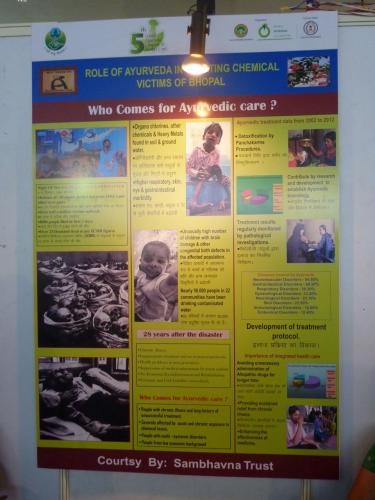
The Sambhavna Trust poster at the Arogya Expo, 5th World Ayurveda Congress 2012
The continuing problems with chemical exposure are not, of course, linked to the gas escape that killed and maimed thousands. The fact is that Union Carbide, subsequently bought out by Dow Chemicals and then shut down, was deeply irresponsible, exploitative and reckless in many of its activities. The main source of the ongoing chemical exposures is groundwater seepage from three ‘solar evaporation ponds’ — or open air chemical dumps — that Union Carbide used for years, into which it dumped all manner of wastes from its pesticide manufacturing plant. To date, no corporate, government or non-governmental entity has stepped forward to ameliorate the dump; not even Dow Chemicals, which claims the dump's not its responsibility as it bought Union Carbide after the disaster. The chances are that Dow’s real reasons for not taking responsibility might be somewhat different. As the manufacturer of Agent Orange, millions of gallons of which was sprayed as a defoliant in Vietnam over several years, Dow is likely more than a little worried that, if it dealt with Bhopal, it would also have to take responsibility for the health disasters still facing the people of Vietnam.
Extract of BBC documentary One Night in Bhopal
Those living in the shanty areas around the vicinity of Union Carbide’s dumps drink contaminated groundwater from their wells. The Sambhavna Trust says these people experience much higher rates of conditions ranging from skin diseases, to respiratory, fertility and gynaecological problems, through to cancer, developmental and birth defects. The Trust’s view is supported by the Indian Council for Medical Research, which estimates a morbidity rate of some 22% as against 9% in unaffected areas. With nearly 30 years of suffering, those affected have no option but to continue to demand justice.
So why was the Sambhavna Trust at the Ayurveda Congress? It was evident from the conversations I had with volunteer practitioners working on behalf of the Trust that they were deeply enthusiastic about the results they were getting using Ayurveda. Healthcare, Ayurveda-style, is delivered in one of the 4 doctors rooms, two Panchkarma treatment rooms, gynaecological suite, or the yoga room within a lovely building that surrounds its own peaceful medicinal herb garden. The building also has its own pathology laboratory and a dispensary, and is in the Blue Moon district of Bhopal. The volunteers were clear that Ayurveda had delivered much better results than efforts with conventional medicines — and, given that the volunteers are offering free medical support, Ayurveda is also considerably more cost effective.
It was only after I spoke with the Sambhavna Trust representatives that the choice of location for the 5th WAC made sense to me.
Parallel challenge
The challenge with some conferences is the number of parallel sessions: deciding which sessions to attend is tricky, because invariably your favoured sessions run concurrently. Well, the 5th WAC took the biscuit here! I have never encountered so many parallel sessions, which took place in one of the many marquees erected at the Lal Parade Ground in Bhopal specifically for the event. Many I spoke to were in agreement that the organisers need to address this and hold more plenary sessions in the next WAC, to be held in two years' time. All the same, 1500 abstracts, based on oral, poster and electronic submissions, were published both in hard copy and electronically for the first time, and give some sense of the sheer volume of active research going on — principally in India — in the field of Ayurveda. Almost every aspect is being studied, whether it’s genomics, proteomics, clinical studies, molecular biology, detoxification, studies on modes of action...the list goes on.
International Delegates Assembly
But it was the two afternoon sessions on Saturday (8th December) and Sunday (9th December), the International Delegates Assembly (IDA), that were ‘compulsory’ for those of us non-Indian nationals present. The IDA meetings addressed some of the most pertinent questions facing the development of Ayurveda outside of India, via a series of panellists including the likes of Prof RH Singh (India), Dr Antonio Morandi (Italy), Dr Liaqat Azam (South Africa), Mark Rosenberg (Germany), Prof George Berra (Argentina), Prof Marc Cohen (Australia) and Dr Baswati Bhattacharya (USA).

Prof RH Singh, leading Ayurveda expert
Among some of the central questions discussed was the apparent lack of growth of Ayurveda outside India over the last 10 years. Many argued that there were a number of roadblocks, including the difficulty in translating Ayurvedic concepts into ones understandable or acceptable to mainstream medicine, and increasing regulatory pressures that were difficult for traditional Ayurvedic manufacturers to meet.
However, another recurring theme was the perception of the safety of Ayurvedic herbal formulations. This issue has two distinct threads to it.
Firstly, there have indeed been isolated cases of contamination caused by pesticides or lead from roadside pollution. But these problems pale into insignificance compared with the risks from conventional drugs or even the risk of food-borne illness in Western countries. This is also an issue that is being actively addressed by the Indian government (Department of AYUSH), trade associations, and the manufacturers themselves.
Secondly, there is confusion in the West over the toxicity associated with the rasa shastra tradition in Ayurveda, which involves the use of metals that are prepared in specific ways so as to eliminate their toxicity to the patient while enhancing their therapeutic properties. Western analytical methods used to measure metals in herbal products usually only measure the total amount of metal present, not the amount that is actually bioavailable to the body.
These discussions aside, there was a feeling of frustration among some of the Ayurvedic doctors present. Many are concerned about things they found challenging to discuss in a public forum. The concerns include the way in which Western cultural and scientific processes are continuing to fragment the 4,000-year-old tradition of Ayurveda. This is partly because reductionism is so in-built within the Western psyche, and has long been integral to Western scientific methods of learning. But it’s also been for commercial reasons. This has led to the exporting of panchakarma to expensive spas, the practice of yoga in fitness centres and the Westernisation of approaches to herbal formulation.

Left to right: Dr Liaqat Azam (South Africa), Dr Baswati Bhattacharya (USA) and the author
(Re-entry) AYUSH
The Department of AYUSH, in the Indian Ministry of Health and Family Welfare, has long taken a guiding role in overseeing the various systems of Indian medicine. Some, however, have been frustrated by the seeming lack of governmental cooperation and support in recent years, and by the ongoing erosion of Ayurveda caused in part by the aggressive marketing of conventional, allopathic medicine by Western drug companies.
On Saturday, we were notified by the WAC organisers that a group of senior officials from AYUSH, most notably its new Secretary, Sh Anil Kumar, wanted to hear the concerns of the IDA in a 1.5-hour meeting the following day. Among Mr Kumar’s passions is improved global recognition of Ayurveda. The organisers asked Dr Oliver Werner of Maharishi Products Europe, Mark Rosenberg of Germany’s European Academy of Ayurveda and myself to present to AYUSH.
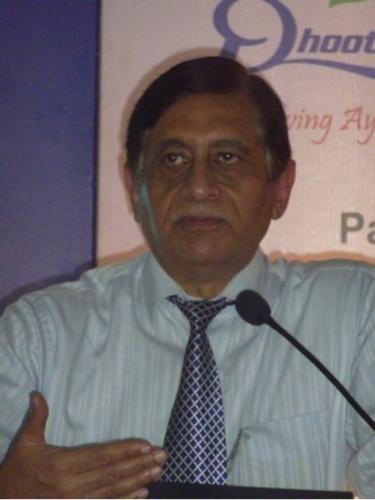
Sh Anil Kumar, the new Secretary of the Department of AYUSH
We laid out our case in relation to some of the problems being faced in Europe, explaining the incompatibility of the EU herbal directive, the challenges facing increasing numbers of unauthorised EU novel food classifications and the lack of interest shown by the European Commission in progressing any kind of framework for the practice of Ayurveda or other traditional systems of medicine, something that is especially relevant to practitioners who are not also registered as medical doctors.
We also proposed ways in which AYUSH could help, as laid out in the final slide of my presentation, below.
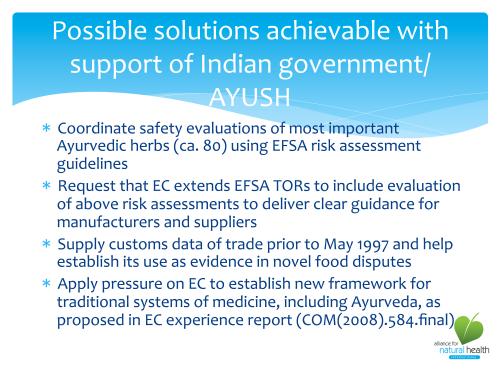
Requests put to the new leadership of AYUSH to facilitate trade of Ayurvedic products in Europe
Given the past, seeming intransigence on the part of AYUSH, there now appeared — perhaps because of the new energy behind Mr Kumar’s leadership — a genuine desire to deliver. On this, we will keep you informed.
One Ayurvedic doctor’s view
I spoke to Dr Anath Ram Sharma, Associate Professor at the Amrita School of Ayurveda in Kollam, Kerala about his concerns. His view echoed those of a number of other younger doctors I met during the course of the Congress.

Dr Anath Ram Sharma, Associate Professor at the Amrita School of Ayurveda, Kerala
On the question of basic, classical Ayurvedic preparations, such as juices and decoctions, Dr Sharma said the following: “These ingredients were natural and relied solely on natural systems of preservation. Then the Ayurvedic pharma companies came and started to add chemical preservatives for bulk production. Sodium benzoate is widely used and not always included on labels. It can cause problems such as hyperactivity and gastric problems in children. The quantities used are also very high and even higher than permitted in the USA or Europe.”
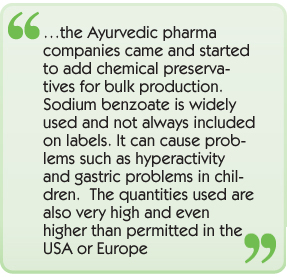
Dr Sharma was equally concerned with the move toward Western-style alcoholic extracts. He said, “Ayurveda traditionally uses natural water extraction decoctions, or milk or other liquid media. The tendency has been to move to pharmacological preparations and delivery systems, putting into syrups, capsules and tablets, and using more and more alcohol extracts. In traditional Ayurveda, only self-generated alcohol should be used. Another problem with the use of extracts are complications or side effects caused by an imbalance in the plant constituents when compared with the more balanced, better tolerated and more effective forms you get from water-based extracts that contain a full spectrum of constituents that work synergistically together.”
Dr Sharma had other concerns over the ‘modernisation’ of Ayurveda. These included the fast-tracking of panchakarma therapies. He told me, “Full panchakarma therapy is one and a half months. But owing to people’s time pressures, they often ask for panchakarma or massage to be done in one day. This is the wrong practice and the wrong application of panchakarma, in which some people may require application of all the 5 procedures, depending on body needs, ailments, climate and so on.”
Indigenous knowledge at risk of being lost
Another Ayurvedic doctor I met, Dr Amrit Nampalliwar, was in the late stages of completing a supplementary PhD. Among his passions is the retrieval of ancient knowledge from elders in remote areas. He believes such elders retain invaluable knowledge and experience with the use of local plants that isn’t always documented. Dr Nampalliwar had visited a remote, local forest area of Nanded district, Maharashtra, and found a 109-year-old elder who had a very broad knowledge of the local flora, along with their preparation and medicinal use. One such plant was Enicostemma littorale, known also as ‘Mamajjaka’ in Sanskrit, ‘Nahi’ in Hindi and ‘Kadu nai’ in Marathi. While it was interesting to read a copy of Dr Sharma’s recent paper showing anti-diabetic effects of the herb in rats, and hear about his current human clinical studies, it was the story of the old man that I found so fascinating. He had apparently never put a single synthetically produced drug into his body, he had used only locally sourced and prepared herbs for any ailment he had ever developed, he’d always eaten a simple but wholesome diet of locally grown produce, and he had an extraordinary knowledge of the local medicinal plants and methods for their preparation and use. But most remarkably — he appeared to be lithe and fighting fit at nearly a decade past his centenary year!
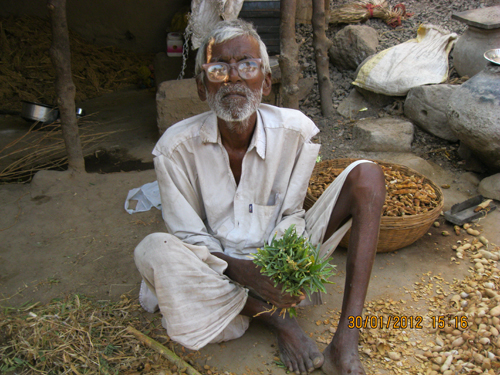
109-year-old plant medicine expert, holding a bunch of Mamajjaka (Enicostemma littorale)
Dr Nampalliwar emphasised the great need for younger doctors to get out into remote areas and visit these elders, as they are a mine of information that is at risk of being lost. Quite simply, he remarked, sitting behind a computer all day searching for medicinal plants will never deliver the kind of knowledge and experience that can be gained by visiting rural areas in search of local Ayurvedic knowledge. Dr Nampalliwar is highly motivated to continue his explorations — but he is saddened that many others he knows are not.
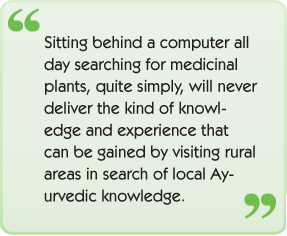
Conclusions
Globalisation and Westernisation have historically tended to go hand in hand. India wants to globalise Ayurveda, but naturally enough, those who fully understand and respect the 4,000-year-old tradition — ‘the science of life’ — are concerned that it is at grave risk of being dismantled, Western-style.
It may be that it isn’t too late. It may be that the new, inspiring generation of Ayurvedic doctors, some of whom I was fortunate enough to meet at the WAC, will prevent further dismantling of this extraordinary, complex and living system of healthcare and lifestyle management.
There is also a sea change in scientific thought taking hold in the West that could reverse some of the existing, untoward trends. This is the shift away from reductionist processes and toward systems processes. It's true that many of us owe much of our existing knowledge and understanding of the world around us to Western scientific methods that have broken down and compartmentalised science and research. However, the move toward multi- and inter-disciplinary research and systems biology approaches, as are increasingly being applied to medical research, may have come just in time.
It is clear that Ayurveda in its full, holistic glory, from its specific approach to individualising diet and lifestyle, through to its detoxification and health promotion procedures and approaches to mind-body-spirit balance, has never been more relevant than it is today.
And it should be no surprise that Ayurveda has found itself to be the medical system of choice among Bhopal’s victims of unparalleled corporate negligence.








Comments
your voice counts
13 December 2012 at 12:01 am
The irony of western medicine's beef against Ayurveda is that it's not scientific. While western pharmaceuticals may have been tested in labs on caged animals etc for a few years Ayurveda has passed the true scientific test: tested on probably millions of humans over thousands of years. Surely, if it was ineffective or dangerous the market place would have rejected it years ago!
18 December 2012 at 11:02 am
To the western human mind, it appears that the format (lab reports presented at prestigious conferenses, nicely presented data written by official departments etc) is more important/has more power than the content (shown healing properties without any harm, personal common sense, and heart). We have lost a lot of what an individual originally was - a human being.
I would be interested to see a list of the ca 80 most important ayurvedic herbs.
Thanks,
Lollo
20 December 2012 at 3:57 am
Hi Robert,
I got to the expo on 9th Dec, weary eyed straight from a long flight and no sleep. It was a shame that I could not meet with you over last few days.
Spoke with several companies there, who were oblivious with eu regs.
staying at ayur centre, that exports there herbs to there euro centres, and then they sell on to patients. they have no idea, and dont want to know about these regs. Afer my treatment is finished, I may buy 6 months worth of herb meds. once it is finished, will I still be able to buy it from a practitioner in eu, or will i have to make special trip every yr to india?
It is good news to see ayush under new management, but is it a little bit too late?
i feel with the rest of the world outside eu and usa, embracing ayur, these regs may just fall apart after a few years, or is that just wishful thinking.
Hope you had a good few days in India, and keep on doing the good fight.
Om Tat Sat (Long live the truth), God Bless,
Sagar
22 December 2012 at 8:00 pm
Hi Robert
I came on your site via a post on facebook by the Sambhavna Trust Clinic. I was there in 2011 for three months, working at both Sambhavna and the Chingari Centre for children with disability. As a complementary therapist (bodywork) I worked with the Panchkarma therapist at Sambhavna and the physiotherapists at Chingari.
I just wanted to correct your statement that treatment is “delivered from a single-room, corrugated iron clinic”. It is much more sophisticated than that. It is true that the manufacturing unit itself is what we might call a large set of sheds at the bottom of the garden, but it does now have a manufacturing licence to sell or give outside the centre. However, the whole centre is a lovely building around a peaceful garden courtyard with 4 doctors rooms, two Panchkarma treatment rooms, a gynaecological suite, a yoga room, a pathology laboratory and a dispensary. Plus meeting rooms and offices, all with a networked computer system for record keeping. And some volunteer accommodation.
Indeed, if people follow the link attached to those words in your article they will be taken to the website of the Bhopal Medical Appeal where they can see for themselves. You can also look at the Bhopal Book page of my website www.spineworks.eu where there are pictures of Sambhavna and Chingari as well.
It is also true that they have found the Ayurveda treatments to be superior to allopathic treatment for long-term treatments – though they do offer that as well.
With much love, ian jarvis
02 January 2013 at 1:46 pm
Thank you Ian for correcting us! We were obviously given incorrect information so have changed the article as you advised.
Your voice counts
We welcome your comments and are very interested in your point of view, but we ask that you keep them relevant to the article, that they be civil and without commercial links. All comments are moderated prior to being published. We reserve the right to edit or not publish comments that we consider abusive or offensive.
There is extra content here from a third party provider. You will be unable to see this content unless you agree to allow Content Cookies. Cookie Preferences